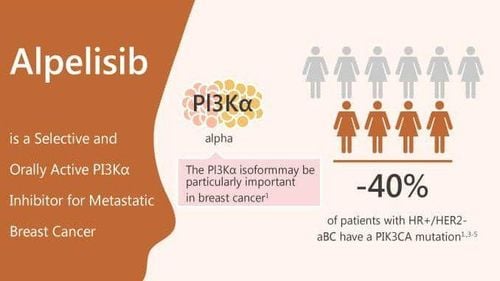This is an automatically translated article.
Pain caused by cancer metastasis to bone is a chronic pain condition with complex pathogenesis and impact on physical, psychological and daily activities of cancer patients. Over the years, many different modalities of treatment for pain caused by metastatic bone cancer have been tested and certain achievements have been achieved. These methods are presented in turn as follows:
1. Non-Steroidal Anti-Inflammatory Drugs
Non-steroidal anti-inflammatory drugs have long been used for pain control treatment for all diseases. They also have anti-inflammatory effects, making them an ideal drug for inflammation caused by certain cancers during invasion and widespread tissue destruction, including cancers that have metastasized to bone.
The basic mechanism of non-steroidal anti-inflammatory drugs is the inhibition of cyclooxygenase (COX) enzymes involved in the production of prostaglandins to regulate various cellular functions including pain perception. In tumor cells, COX-2 was increased in activity.
Therefore, reducing COX activity will also inhibit pain perception. Therefore, clinicians have indicated acute use of selective COX-2 inhibitors in patients with cancer-related bone pain and have shown efficacy in reducing tumor burden and cell destruction. osteoclasts in addition to significantly reducing pain.
The main limitation of non-steroidal anti-inflammatory drugs is their short duration of action and lack of long term effects.
2. Opioids
The second most commonly used drug is opioids. It is one of the most effective and widely used drugs for pain relief from cancer, including cancer that has spread to the bones. Opioids produce long-lasting pain relief. As a result, more than 80% of cancer patients need opioids to improve or control pain for part of their lives.
The analgesic effect of opioids depends largely on μ-receptor saturation and is therefore influenced by the type and severity of pain, previous exposure to opioids, and the distribution of each receptor .
The main side effects of opiates are physiological dependence, addiction, sedation, constipation, nausea, vomiting, and respiratory depression that limit their use.

Sử dụng thuốc Opioid trong giảm đau do ung thư di căn đến xương
3. Bisphosphonates
The third most commonly used drug is a bisphosphonate, which is commonly used to treat hypercalcemia in the body. These drugs improve the acidic microenvironment of bone tissue in localized or metastatic tumors, reduce bone solubility and thus reduce acid-inducible ion activation, thus providing relief from pain caused by cancer .
Bisphosphonates should be considered the mainstay of treatment when analgesics and radiation are not effective in treating bone cancer pain. However, these drugs are safe to use but have not been shown to be the most effective treatments for pain from cancer metastases.
4. Tricyclic Antidepressants
Another drug used to treat bone pain in metastatic cancer is tricyclic antidepressants in cancer patients due to their positive effects on mood and sleep. The effectiveness of these drugs in the treatment of malignant pain is limited, but their use in the treatment of non-malignant pain has been well studied and proven.
The mechanism of analgesic action of the drug is to alter pain perception and reduce depressive symptoms in cancer patients. Therefore, their use may be justified because they have antidepressant effects that help patients with terminal cancer.
However, the use of tricyclic antidepressants, particularly in patients who are elderly or with severe comorbidities, may be limited because of frequent adverse events similar to those observed in patients with severe comorbidities. Common side effects with opiates, include somnolence, constipation, urinary retention, and dry mouth, as well as serious side effects orthostatic hypotension, coma, impaired liver function, and cardiotoxicity. In these situations, some selective serotonin reuptake inhibitors (SSRIs) such as paroxetine, citalopram, and selective norepinephrine reuptake inhibitors (SNRIs) such as venlafaxine and duloxetine have been shown to be effective. alternative in the treatment of neuropathic pain.

Thuốc chống trầm cảm ba vòng tác động đến giấc ngủ của người bệnh
5. Corticosteroids
Corticosteroids belong to another major class of drugs that are widely used as adjunctive therapy for cancer-related pain syndromes. These are bone pain, neuropathic pain due to invasive or metastatic compression of nerve structures, headache due to increased intracranial pressure, arthralgia, pain due to ongoing inflammation and pressure on structures. surrounding structures and pain due to obstruction of hollow organs or distention of an organ.However, it should be noted that corticosteroids when used for a long time can cause significant side effects such as immunosuppression, hypertension, hyperglycemia, peptic ulceration, and psychosis. Although in cancer patients, especially in late-stage or metastatic bone cancers, the risk-benefit analysis still shows that the benefits outweigh the risks, especially in cases associated with cancer. related to the central nervous system.
6. Growth factors and signaling molecules
Another treatment modality that also aids in pain relief from metastatic cancer is the use of growth factors and signaling molecules. Representative is osteoprotegerin, an inhibitory regulator of osteoclasts.
As a result, when bone destruction is inhibited, it helps to reduce the amount of bone that is damaged and therefore reduces pain. Besides, this also helps to reduce the number of pathological fractures and the pain associated with metastatic cancer.

Các cơn đau do ung thư di căn ảnh hưởng đến chất lượng cuộc sống của người bệnh
7. Endothelin-1 . receptor antagonists
Endothelin-1 (ET-1) is a neurotransmitter secreted by neurons or both non-neuronal cells and tumor cells. Hyperkalemia in bone metastases occurs due to sensitization of afferent receptors containing ET-1 receptors. Thus, ET-1 receptor antagonists reduce bone pain by antagonizing the effects of nociceptive stimuli at the receptors.
Drugs of the endothelin system, such as atrasentan, have been studied for the clinical treatment of cancer pain that has spread to the bone by releasing beta-endorphin and activating the opioid class. These antagonists have indirect effects as well as reduce the disruption of cell junctions preventing metastasis. Therefore, this class of drugs is considered as new advances in the treatment of bone pain in metastatic cancer.
8. Radiation therapy
Radiation therapy is the most effective treatment for pain relief in patients with metastatic bone cancer. Numerous observations have shown that patients receiving radiation therapy experience partial or complete pain relief within 10-14 days of initiation.
Three types of radiation therapy are used to treat pain from metastatic bone cancer: external beam radiation therapy, systemic irradiation, and radiopharmaceuticals.

Phương pháp xạ trị được sử dụng để điều trị đau do ung thư di căn xương
9. Surgical intervention
Surgery is very rarely considered an option to treat bone pain caused by metastatic lesions. This indication is no longer common because the various pharmacological agents mentioned above have over the years achieved relatively adequate control of pain from bone metastases.
Two types of surgical modalities still in use today are nerve destructive and neuromodulatory:
Nerve ablation is a way of relieving nerve pain by causing damage and disrupting nerve endings. pain pathway that carries signals through the spinal cord to the brain. This disruption can be done to any degree, be it nerve, nerve root, nerve root ganglia, spinal cord, thalamus or brain stem, or a combination depending on the severity of the disorder. the pain.
Nerve conditioning with electrical energy is the second surgical method to treat cancer pain that has spread to the bone. This procedure involves electrical stimulation of the peripheral or dorsal nerves of the spinal cord and brain to address neuropathic pain.
In summary, there are many modalities of pain relief from metastatic cancer that are being implemented. The choice of method depends on the specific situation, but they all share the same goal of safely controlling pain for the patient, combined with other palliative care therapies to improve the quality of life. Overall survival of patients with end-stage metastatic cancer.
For patients with terminal cancer who respond poorly to pain relievers, modern surgical intervention is the solution being applied by Vinmec International General Hospital. Example:
Alcohol denervation to treat pain caused by tumor invasion of peripheral nerves. Canceling the solar plexus in visceral pain in pancreatic cancer, stomach cancer... Canceling the hypogastric plexus in cancers that invade the pelvic region such as prostate cancer, cervical cancer. Continuous epidural anesthesia, spinal anesthesia with intramedullary injection chamber to control symptoms of late stage cancer.... Thus, there are now many methods and drugs to treat pain in stage cancer. Finally, depending on the condition of the disease, the cancer lesions, the doctor will prescribe the appropriate drugs and interventions.
If you have a need for consultation and examination at Vinmec Hospitals under the national health system, please book an appointment on the website for service.
Please dial HOTLINE for more information or register for an appointment HERE. Download MyVinmec app to make appointments faster and to manage your bookings easily.













